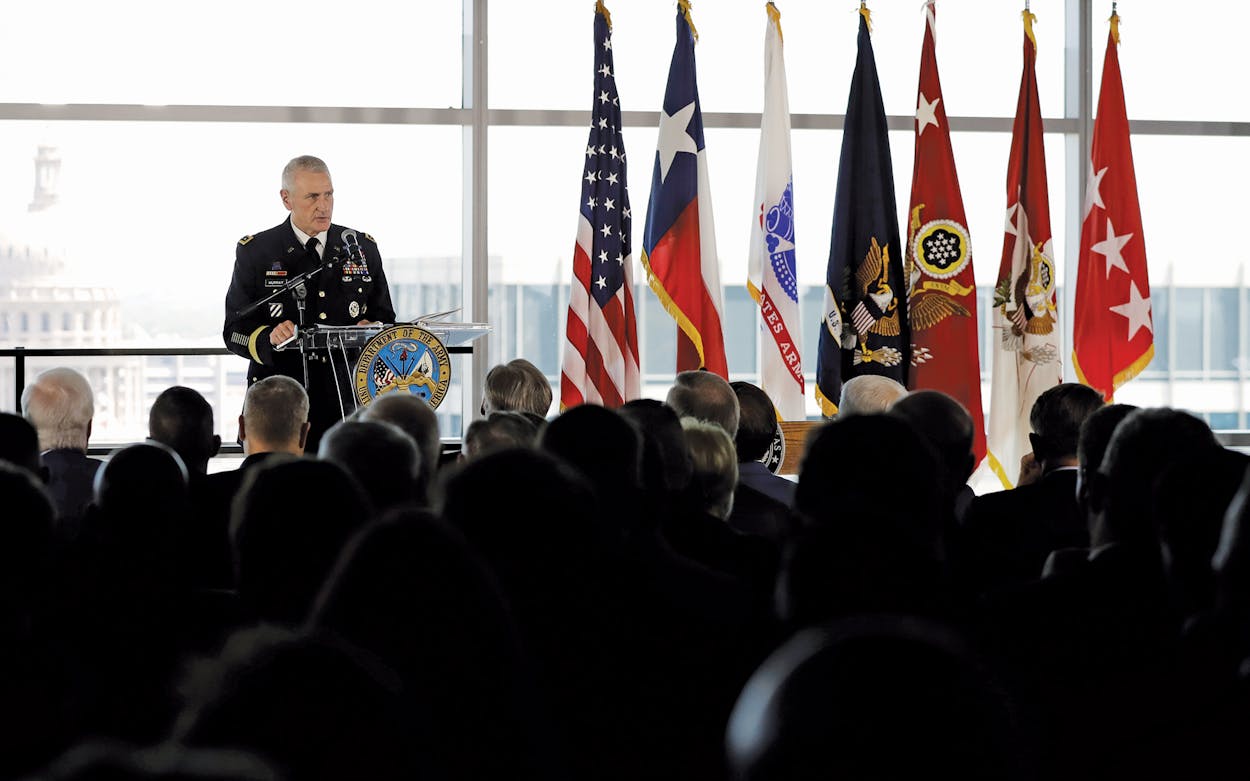A crowd of several hundred uniformed military officers, state and local politicians, and journalists gathered on the nineteenth floor of the University of Texas System’s new administration building in downtown Austin on Friday to witness the official activation of the U.S. Army Futures Command, an ambitious new initiative that has been described as the biggest reorganization of the Army since 1973. In development for three years, the new command is intended to accelerate and improve Army procurement processes that have repeatedly gone over schedule and over budget.
The event began with remarks by Secretary of the Army Mark Esper, Governor Greg Abbott, Senator John Cornyn, and Austin Mayor Steve Adler (Senator Ted Cruz sat in the front row but did not deliver formal remarks). Army Chief of Staff Mark Milley then performed the official activation ceremony by unveiling the command’s colors and shaking hands with its new leader, General John Murray, recently promoted to four-star status.
In his own address, Murray outlined his goals for the command: to help the U.S. Army “remain the preeminent ground force in the world, forever.” It would accomplish this by “making soldiers more effective and more lethal” through faster development and deployment of the latest technology and weaponry.
Austin, with its hippie past and residual weirdness, might seem an odd choice to locate the headquarters of an organization dedicated to “inflicting punishment and destroying the enemy at the least cost to ourselves,” as Milley, the Army chief of staff, put it. The Futures Command will certainly require a cultural adjustment on the part of the Army. The approximately five hundred soldiers and officers assigned to the command will not wear uniforms while on duty and will work out of the downtown UT System administration building, not a military base.
“This is the first time in Army history that we’ve ever planted a major headquarters in the center of an urban area in the United States,” Milley said. “But we’re looking to be disruptive.”
“Disruptive,” “innovative,” and “nimble”—all words familiar to the technology start-up world—were invoked by one uniformed general after another to describe the Army’s goals for the Futures Command, which they hope operates as something between a venture capital investment fund (backed by the largesse of the federal government) and a skunkworks operation, where experimental ideas and prototypes can be developed and tested before being sent out into the field to kill the bad guys. The command is planning to collaborate with the Capital Factory, an Austin business incubator.
Adopting more start-up lingo, Army Secretary Esper acknowledged that some of the Futures Command’s innovations will fail, but said he hoped they would “fail early and fail cheap.” This restless experimentation was preferable to the Army’s current procurement system, which he described as “slow, cumbersome, and bureaucratic.”
Adler, the Austin mayor, made an awkward attempt to make the Futures Command sound like the most natural possible outgrowth of the city’s “keep it weird” image: “Being weird means, in this city it’s okay to take risks,” he suggested. “It’s okay to be different in this city. That’s why you can walk down the street and see people with red hair, or see someone riding a bicycle in a thong.”
Milley, following Adler onto the dais, said he “just got a weird image of General Murray riding down the road in a thong. I hope that doesn’t ruin my day.” When it was his turn to speak, Murray promised Adler that he “would do all I can to keep Austin weird. With the exception of riding a bicycle in a thong.”








